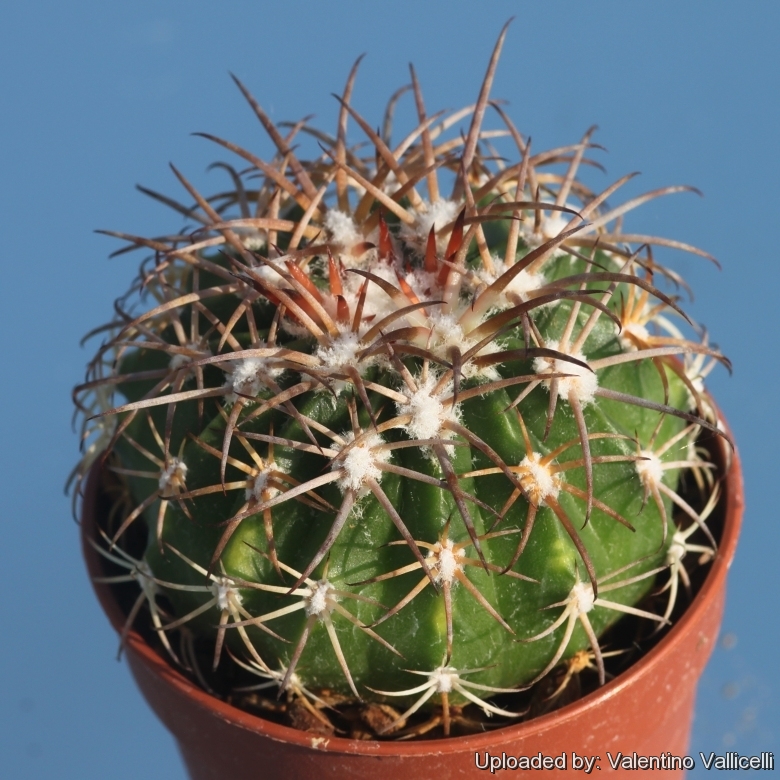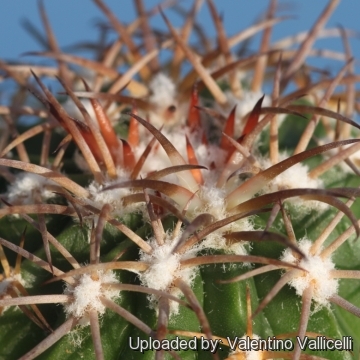= Melocactus peruvianus var. amstutziae Rauh & Backeb. in Rauh
Sitzungsber. Heidelberger Akad. Wiss., Math.-Naturwiss. Kl. 1958(1): 531
Accepted Scientific Name: Melocactus peruvianus Vaupel
Bot. Jahrb. Syst. 50(2-3, Beibl. 111): 28. 1913 [19 Aug 1913]

Melocactus amstutziae (Melocactus peruvianus var. amstutziae) Photo by: Valentino Vallicelli
KK539 (Collector: Karel Kníže) Locality: Rio Santa, Peru, altitude: 1600m
Origin and Habitat: Peru, Rio Santa Maria,
Altitude: 1600 m a.s.l.
Synonyms:
See all synonyms of Melocactus peruvianus
back
Accepted name in llifle Database:Melocactus peruvianus VaupelBot. Jahrb. Syst. 50(2-3, Beibl. 111): 28. 1913 [19 Aug 1913]Synonymy: 13
back
Common Names include:
ENGLISH: Turk's Head Cactus, Melon Cactus, Turk's Cap Cactus
FINNISH (Suomi): Melonikaktukset
GREEK (Ελληνικά): Μελόκακτος
ITALIAN (Italiano): Melocactus
JAVANESE (Basa Jawa): Melon kaktus
LITHUANIAN (Lietuvių): Vainikūnas, Karūnis
RUSSIAN (Русский): Мелокактус
SLOVENIAN (Slovenščina): Melonar
SPANISH (Español): Melocactus
SWEDISH (Svenska): Melonkaktussläktet
UKRAINIAN (Українська): Мелокактус
Description: This is probably one of the many geographical forms of Vaupel's Melocactus peruvianusSN|12607]]SN|12607]].
Ribs: About 13.
Spines: Spines 6-8(-9), up to 2.5 cm long, angular and keeled above, dark brown
Cephalium: With reddish bristles.
Flowers: Red.
Subspecies, varieties, forms and cultivars of plants belonging to the Melocactus peruvianus group
Bibliography: The Cactus and Succulent Journal of Great Britain Volume 43/Number 1 - February 1981
 - KK583 Rio Rimac, Peru. Altitude: 1200 m. (Melocactus peruvianus var. amstutziae) Photo by: Valentino Vallicelli
- KK583 Rio Rimac, Peru. Altitude: 1200 m. (Melocactus peruvianus var. amstutziae) Photo by: Valentino Vallicelli Melocactus amstutziae (Melocactus peruvianus var. amstutziae) Photo by: Valentino Vallicelli
Melocactus amstutziae (Melocactus peruvianus var. amstutziae) Photo by: Valentino VallicelliCultivation and Propagation: These tropical cacti are not the easiest things to grow and aren’t plants for beginners.
Growth rate: It is a relatively rapidly growing given the best conditions.
Soils: It likes very porous standard cactus mix soil.
Repotting: The root system is weak and generally resents being repotted and can take a long time to re-establish. Use pot with good drainage.
Light: They prefer very bright light, not as much as the most arid growing cacti, but plenty nonetheless. Tends to bronze in strong light, which encourages flowering and heavy spine production.
Watering: Melocacti grow from April to October and cannot endure long stretches of total dryness, and also too much water will rot them, as their weak root systems tends to be inefficient at sucking up water from wet soil. Nonetheless, again as a result of their tropical origins, they need a fair amount of water, but allow the soil to dry quite a bit before watering again.
Fertilization: Do not feed in winter.
Hardiness: Melocactus rest from October to April but can’t stand cold, or even fairly cool temperatures, so is indispensable to keep them above 8-12°C at all times, severe damage or death occurring at temperatures that the great majority of cacti wouldn’t mind in the least and prefer more frequent water in winter than other cacti, say once a month. (but hardy to 4 C ° C for short periods). However warmth throughout the year will increase the grower's success (minimum 12° to 20° C during rest season).
Pests & diseases: It may be attractive to a variety of insects, but plants in good condition should be nearly pest-free, particularly if they are grown in a mineral potting-mix, with good exposure and ventilation. Nonetheless, there are several pests to watch for:
- Red spiders: Red spiders may be effectively rubbed up by misting the vulnerable plants every day
- Mealy bugs: Mealy bugs occasionally they develop aerial into the new growth among the wool with disfiguring results, but the worst types develop underground on the roots and are invisible except by their effects.
- Scales: Scales are rarely a problem.
- Rot: it is only a minor problem with cacti if the plants are watered and “aired” correctly. If they are not, fungicides won't help all that much.
Propagation: Exclusively by Seeds. Sow in February-march in a light, sandy, porous soil. Cover germinating tray with glass to prevent seed from drying out. Germination is most successful at a temperature of 18 to 22° C.












